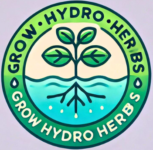Growing Herbs with Hydroponics: Where to start?
Setting up a hydroponic herb garden for beginners is simple!
Get a plastic tote, airstone, pH kit, hydroponics nutrients, and net pots.
Choose easy-to-grow herbs like basil, mint, and parsley. They will thrive with proper care.
Choose LED lights and quality seeds.
Adjust pH, water levels, and nutrients regularly. An airstone boosts oxygen levels for healthy roots. DWC systems reduce plant problems.
Enjoy fresh herbs all year! For best results, ensure that light, nutrient balance, and temperature are just right. Ready to start your own garden oasis? All you need is a little know-how!
GrowHydroHerbs TLDR
- Choose hydroponic-friendly herbs like basil and mint.
- Use quality nutrients such as General Hydroponics FloraGro.
- Ensure proper lighting with LED grow lights.
- Set up an effective aeration system with an airstone.
- Maintain pH levels, water, and nutrient balance regularly.
A Shopping List to Start a Hydroponic Herb Garden for Beginners
Let’s set up your hydroponic herb garden. To be successful, it’s essential to start with a well-thought-out shopping list. Make sure to get the essential equipment like a plastic tote, air pump, and pH testing kit.
Choose the right plants and quality nutrients. Then you need to understand light requirements. Finally, having maintenance tips in place will set you up for herb-growing success in your new hydroponic system.
Essential Equipment Needed
When setting up your hydroponic herb garden, you’ll need a plastic tote for the reservoir. It should have an opaque design to prevent algae growth. This is necessary to maintain the cleanliness of your hydroponic system.
Here’s a list of other essential equipment:
- Airstone: An airstone is key for oxygenating the water in your hydroponic system. It ensures that your herbs receive the necessary oxygen without drowning the roots.
- pH Testing Kit: Having a pH testing kit allows you to monitor and adjust the pH levels of your nutrient solution. This helps in maintaining ideal conditions for nutrient absorption by your herbs.
- Nutrient Solution: Invest in a quality hydroponic nutrient solution like General Hydroponics FloraGro. This will provide your herbs with the necessary nutrients for healthy growth.
- Net Pots: Net pots are ideal for securely holding your herb plants in place within the hydroponic system. This allows for proper root growth and nutrient uptake.
Choosing the Right Plants
Consider choosing herb plants such as basil, mint, parsley, cilantro, and thyme. These plants flourish in hydroponic environments.
When selecting herbs, look for varieties that are well-suited for hydroponic systems. This will guarantee successful growth. Choose herb seedlings or seeds labeled for hydroponic use. This will kickstart your garden effectively.
Take into consideration the space you have available. Also, consider the conditions in your indoor setup when deciding on herb plants to cultivate.
It’s also essential to have the right supplies:
- net pots
- appropriate growing media
- nutrients tailored for hydroponic herb cultivation
Research the specific growing tips and care instructions for each herb plant you choose. This will provide them with the best possible environment for development.
Quality Nutrients Selection
How do you get optimal herb growth stimulation in your hydroponic herb garden? Choose high-quality nutrients such as General Hydroponics FloraGro.
To guarantee your plants receive the proper nutrients, consider the following shopping list:
- Hydroponic Nutrients: Select a reputable brand like General Hydroponics FloraGro to supply essential elements for your herbs’ growth.
- pH Testing Kit: Maintain the correct pH levels in your hydroponic system. Regularly test and adjust the nutrient solution.
- Net Pots: Utilize net pots to securely hold your herb plants in place. This can help enable roots to access water, nutrients, and oxygen.
- Hydroponic Growing Media: Choose a suitable growing medium such as aquarium gravel. This will support your herb plants and provide stability in the hydroponic system.
Furthermore, remember to purchase high-quality herb seeds or seedlings to start your hydroponic herb garden.
With these crucial items, you’ll be on your way to cultivating a flourishing herb garden using hydroponic techniques.
Understanding Light Requirements
Choose LED grow lights with a color temperature of 5000-6500K. This will optimize herb growth in your hydroponic setup. This range mimics natural sunlight, promoting healthy development.
Guarantee your LED lights cover the full light spectrum essential for plant growth. Look for options with adjustable height settings to accommodate different stages of herb growth. By adjusting the height, you can prevent light burn or insufficient lighting.
Calculate the total wattage required based on the size of your herb garden. This will provide adequate light intensity. Aim for 14-16 hours of light daily to simulate the sun’s cycle. Thus, supporting robust herb growth.
LED lights are energy-efficient and long-lasting. This makes them ideal for indoor gardening. With the right light setup, your herbs will flourish year-round. This will provide fresh flavors for your culinary creations.
Maintenance Tips for Success
Purchase the necessary items listed below. This will guarantee successful maintenance of your hydroponic herb garden.
- pH Kit: Regularly test and adjust the pH levels in your nutrient solution. This will achieve ideal nutrient absorption for your herbs. Maintaining the correct pH is vital for healthy root systems and overall plant growth.
- Hydroponic Nutrients: Invest in high-quality hydroponic nutrients. This will provide your plants with essential elements for growth. Monitoring nutrient levels and adjusting accordingly will help prevent deficiencies and support thriving herbs.
- Water Filter: Consider purchasing a water filter. This will help to make sure that the water and nutrient solution you provide to your hydroponic setup is clean and free from contaminants. Clean water is necessary for the health of your plants.
- Monitoring Tools: Equip yourself with tools to monitor water levels, nutrient solution strength, and electrical conductivity. Monitoring these factors will help you maintain ideal conditions for your hydroponic herb garden. This will prevent common issues and promoting successful growth.
Construction of a Hydroponic Herb Garden For Beginners

To construct your hydroponic herb garden, begin by carefully cutting holes in the lid of your container for plant insertion.
Paint the container with dark paint to block light and discourage algae growth, ensuring a healthy environment for your herbs.
Drill a small hole for tubing near the top of the container to facilitate proper oxygenation of the water in the system.
Lid Hole Cutting
Using a template can guide you to accurately cut holes in the lid of your hydroponic herb garden container for net pots. Here’s how to guarantee a proper fit for your net pots:
- Measure Twice, Cut Once: Before cutting, mark the spots where you want to place the net pots on the lid using a template. Double-check the measurements to avoid errors.
- Choose Your Tool: You can use a utility knife for a precise cut or a hole saw for a quicker hole creation. Both tools work well for this task.
- Cutting Technique: Carefully cut along the marked lines on the lid, making sure that the holes are just the right size to snugly fit the net pots without any gaps.
- Test for Fit: After cutting the holes, test the fit of the net pots. They should sit securely in the lid without wobbling. Make adjustments if necessary for a perfect fit.
Dark Light Blocking
Consider applying a dark-colored paint to the container and lid to effectively block out light for your hydroponic herb garden setup.
Dark light blocking is pivotal in preventing algae growth in the nutrient solution, which can impede plant growth. By using a dark paint on the container and lid, you create a light-proof environment that helps maintain the integrity of the nutrient solution.
Algae thrive in the presence of light, and blocking it out is essential for the health of your plants in the hydroponic system. Ensuring that your setup is light-tight will promote prime plant growth and minimize any issues that light exposure can cause.
Tubing Hole Drilling
For a successful hydroponic herb garden setup, drill a 1/4 inch hole near the top of the container to accommodate the airline tubing required in hydroponic systems.
Here’s how to guarantee a proper tubing hole drilling process:
- Choose the Right Spot: Select a location near the top of the container that allows easy access for tubing installation and maintenance.
- Use the Correct Tools: Employ a drill with a sharp bit to create a clean hole without causing damage to the container material.
- Size Matters: Guarantee the hole is precisely 1/4 inch to snugly fit the airline tubing for a secure connection that prevents leaks.
- Secure the Connection: Position the hole strategically to facilitate smooth tubing installation, ensuring a tight seal to maintain the system’s integrity.
Airstone Attachment Method
Attach the airstone firmly to the airline tubing inside the container for best aeration in your hydroponic herb garden setup.
By connecting the airstone to the tubing, you guarantee that oxygen is efficiently distributed to the plant roots in the reservoir.
Remember to incorporate a check valve in the system to prevent any potential water backflow into the air pump, maintaining the integrity of your setup.
Placing the airstone at the bottom of the reservoir is vital as it helps evenly disperse oxygen, promoting ideal aeration levels for your herbs.
Effective aeration through the airstone is essential for preventing root rot and fostering healthy plant growth in your hydroponic garden.
This method plays a significant role in optimizing that your plants can absorb the nutrients they need to thrive.
Make sure to follow these steps diligently to maintain a well-aerated environment for your hydroponic herb garden.
Water and Nutrient Addition
To prepare the nutrient solution for your hydroponic herb garden construction, first add water to the reservoir, making sure it covers the roots adequately without fully submerging them. Here’s how to effectively manage the water and nutrient addition:
- Mixing Nutrients: Follow the manufacturer’s instructions to blend the appropriate amount of hydroponic nutrients into the water. This step is essential for providing necessary elements to support plant growth.
- Monitoring Water Level: Regularly check the water level in the reservoir to prevent it from drying out or overflowing. Maintaining the correct water level is key to the health of your plants.
- Adjusting pH Levels: Test the pH level of the nutrient solution using a pH testing kit. Keeping the pH at the best level ensures that plants can absorb nutrients efficiently.
- Aeration with Air Pump: Use an air pump and airstone to aerate the nutrient solution. Sufficient oxygenation is crucial for healthy root development in hydroponic systems.
DWC System Benefits
To reap the benefits of a DWC system for your hydroponic herb garden, assemble key components such as a reservoir, air pump, air stone, net pots, and clay pebbles for optimal plant growth and yield.
Deep Water Culture (DWC) hydroponic systems are ideal for promoting healthy root development and preventing root rot. In a DWC setup, plant roots are suspended directly in a nutrient-rich solution, allowing for effective nutrient absorption and oxygenation. This method fosters rapid growth and high yields, making it a popular choice among hydroponic growers.
The oxygenated water in DWC systems guarantees that your herbs thrive without the risk of root issues commonly found in soil-based gardening. By providing a stable environment for your plants to thrive, a DWC system simplifies the process of hydroponic growing, making it accessible for beginners.
With the right setup and maintenance, you can enjoy a successful herb garden year-round, thanks to the advantages of deep water culture.
Which Herbs To Grow?
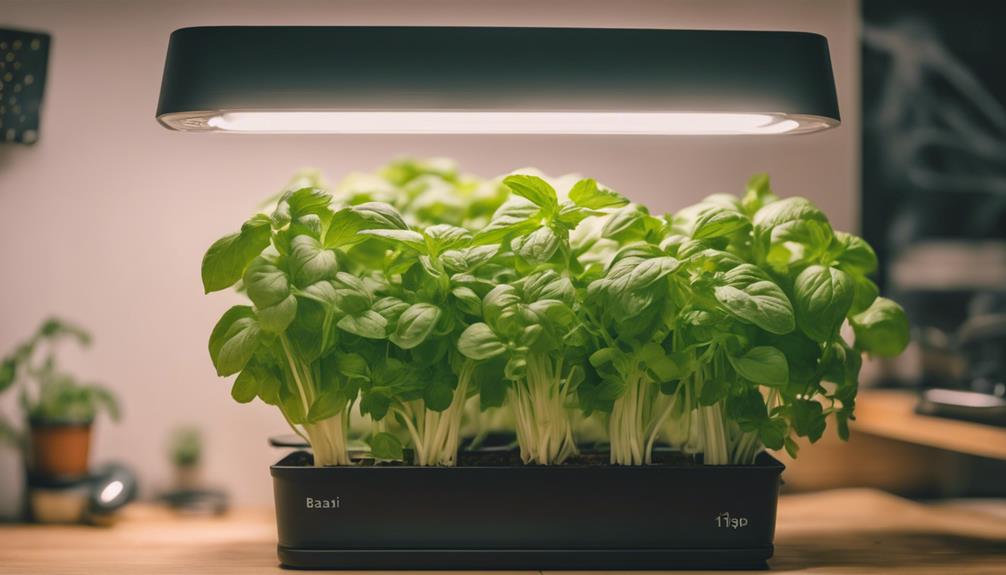
When considering which herbs to grow in your hydroponic herb garden, popular choices like basil, mint, parsley, cilantro, and thyme are excellent options to start with.
Other herbs such as oregano, rosemary, chives, and dill also thrive in hydroponic setups, offering a diverse range of flavors for your cooking needs.
Providing the ideal growing conditions for these herbs will guarantee a successful and fulfilling hydroponic gardening experience.
Popular Herb Choices
Consider popular herb choices for your hydroponic garden for beginners to enjoy a variety of invigorating flavors year-round.
- Basil: Known for its aromatic flavor, basil is a staple in many cuisines and adds a delightful touch to salads, pasta, and sauces.
- Mint: With its revitalizing taste, mint is perfect for beverages, desserts, and savory dishes, making it a versatile herb to have on hand.
- Cilantro: This herb is popular in Mexican, Asian, and Middle Eastern dishes. Cilantro offers a unique flavor that pairs well with spicy foods.
- Parsley: Widely used for garnishing and enhancing the flavor of dishes. Parsley is a versatile herb that adds freshness to salads, soups, and meats.
These herbs aren’t only easy to grow but also thrive in hydroponic systems, allowing you to enjoy a continuous supply of invigorating herbs without the need for soil.
Incorporate these popular herb choices into your hydroponic garden to elevate your culinary experience with homegrown flavors.
Ideal Herb Varieties
For easy hydroponic cultivation, select herb varieties such as basil, mint, cilantro, parsley, and chives. These herbs thrive in hydroponic systems, offering a continuous harvest to elevate your culinary creations with their diverse flavors. Here is a helpful table showcasing these ideal herb varieties for your hydroponic herb garden:
| Herb Varieties | Culinary Uses |
|---|---|
| Basil | Pesto, salads |
| Mint | Cocktails, desserts |
| Cilantro | Mexican, Asian dishes |
| Parsley | Garnishes, soups |
| Chives | Baked potatoes, omelets |
Growing Conditions for Herbs
To guarantee successful growth in your indoor hydroponic herb garden, it’s important to understand the specific growing conditions that different herb varieties require.
- Choose the Right Herbs: Popular choices for hydroponically grown herbs include basil, mint, parsley, cilantro, and chives.
- Consider Specific Needs: Different herbs have unique requirements for light, temperature, and humidity levels.
- Adapt to Preferences: Herbs like rosemary and thyme prefer drier conditions, while basil and mint thrive in more moisture.
- Plan Accordingly: When setting up your hydroponic herb garden, take into account the growth habits of each herb to optimize space and resources efficiently.
Taking Care of Your Garden
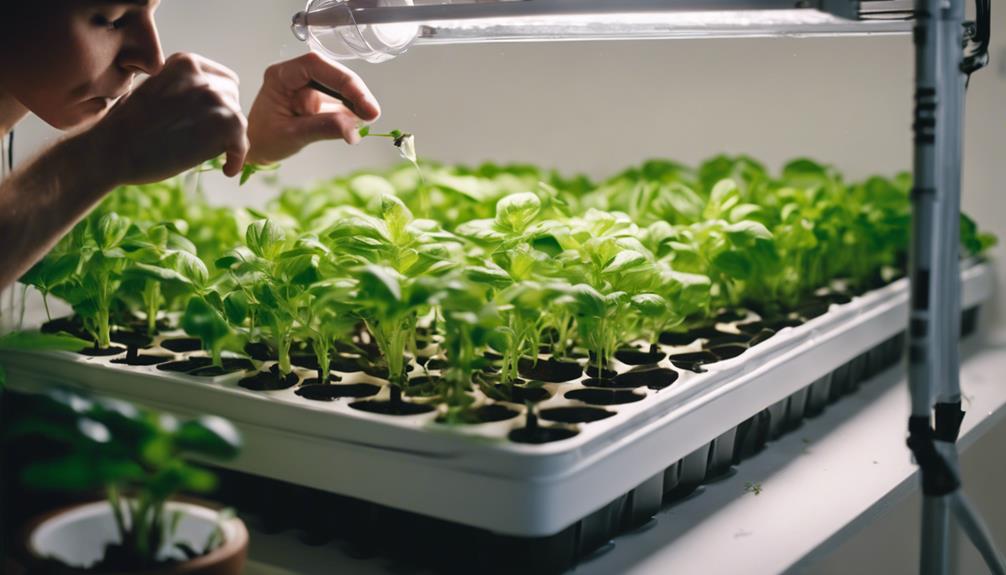
Monitor the pH levels regularly to make certain your hydroponic herb garden thrives with peak nutrient absorption. Adequate air circulation is crucial for healthy herb growth. Maintain ideal temperature (60-70°F) and humidity (40-70%) levels to prevent diseases. Adjust nutrient levels as needed to meet the specific needs of different herbs. Guarantee your garden receives 14-16 hours of light daily for best photosynthesis and growth.
| Care Tips | Description |
|---|---|
| Monitor pH Levels | Check and adjust pH levels to ensure proper nutrient uptake by your hydroponically grown herbs. |
| Air Circulation | Provide sufficient airflow to prevent fungal issues and promote robust growth of your plants. |
| Temperature & Humidity | Maintain temperatures between 60-70°F and humidity levels between 40-70% for ideal herb growth. |
| Nutrient Levels | Regularly assess and modify nutrient levels to support the diverse requirements of your herbs. |
| Light Exposure | Make sure your garden receives 14-16 hours of light each day to facilitate healthy plant growth. |
Related Posts
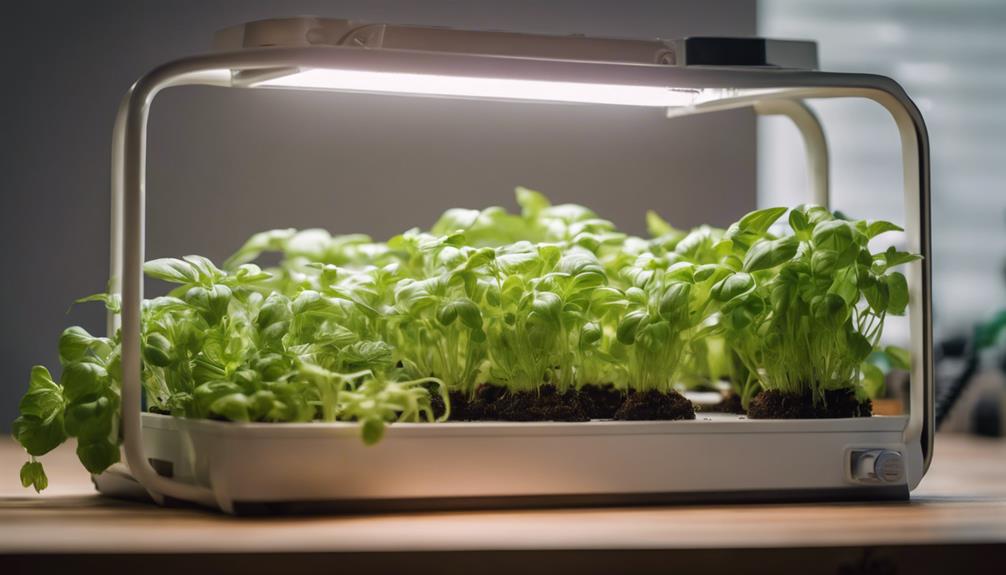
Explore additional resources and inspiration in the world of hydroponic herb gardening through these related posts:
- Advanced Tips for Indoor Hydroponic Herb Gardening: Dive deeper into the world of hydroponic gardening with advanced tips and tricks. Explore different hydroponic systems, nutrient solutions, and lighting options for best plant growth.
- 11 Herbs you can start with: Get started on your journey of growing herbs hydroponically with this guide to herbs that do well hydroponically.
- Hydroponic Kits: Discover kits that allow you to start growing herbs without any setup. This is a relatively inexpensive way to start growing herbs in your kitchen.
Why Start An Indoor Hydroponic Herb Garden?
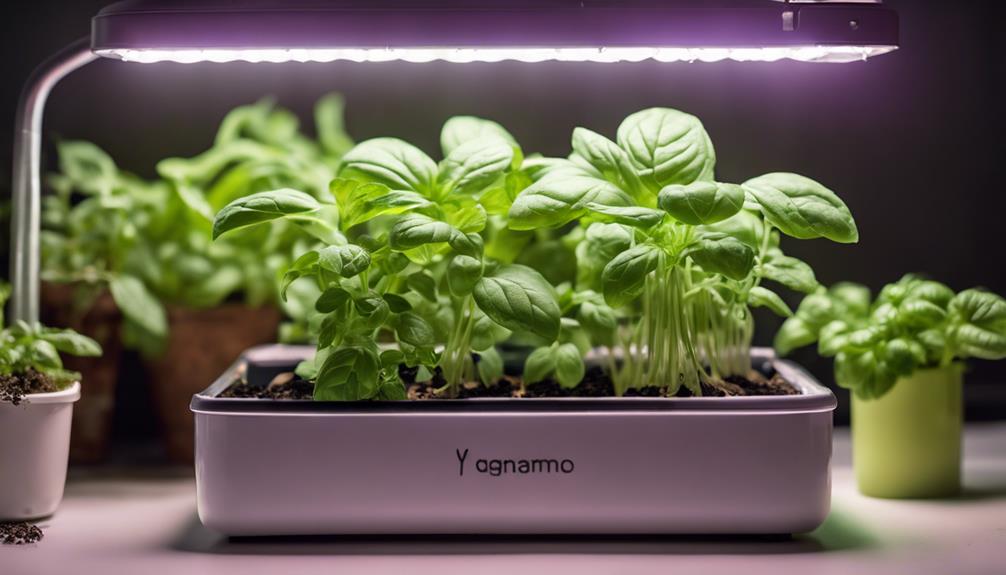
Starting an indoor hydroponic herb garden offers numerous benefits, including access to fresh herbs year-round and the convenience of gardening regardless of the weather outside.
With indoor gardening, you can enjoy a variety of herbs without worrying about seasonal limitations, all while saving space and reducing mess by eliminating the need for soil.
Benefits of Indoor Gardening
When considering an indoor hydroponic herb garden, you open the door to a range of benefits that enhance your herb-growing experience. Here are some compelling reasons to start your indoor garden:
- Fresh Herbs Year Round: With indoor gardening, you can enjoy fresh herbs regardless of the season, ensuring a constant supply for your culinary adventures.
- Save Money: By growing your herbs indoors, you can save significant amounts over time by eliminating the need to purchase expensive store-bought herbs regularly.
- Free of Contaminants: Indoor hydroponic systems reduce the risk of contaminants like pesticides and herbicides, providing you with cleaner and safer herbs for consumption.
- Vigorous Growth: Hydroponic setups offer efficient nutrient delivery, promoting vigorous herb growth and healthier plants compared to traditional soil-based methods.
Embracing indoor gardening not only offers convenience and accessibility but also contributes to a sustainable and cost-effective approach to herb cultivation.
Year-Round Fresh Herbs
Considering the benefits of indoor gardening, such as year-round access to fresh herbs, it’s evident why starting an indoor hydroponic herb garden can enhance your culinary experience and sustainability efforts. By growing herbs in hydroponic systems indoors, you maintain a constant and convenient supply of year-round fresh herbs for all your culinary needs.
These indoor hydroponic herb gardens provide a space-efficient solution, perfect for apartments or homes with limited outdoor areas. With hydroponic systems, the need for soil is eliminated, reducing the risks of pests and diseases that often plague traditional gardens. This control over light, temperature, and nutrient levels allows beginners to successfully cultivate a variety of culinary herbs indoors, regardless of the season.
Not only is starting an indoor hydroponic herb garden cost-effective, but it also ensures a continuous harvest of flavorful and aromatic herbs throughout the year. Make the most of your indoor space by creating a sustainable and rewarding herb garden that will elevate your cooking and wellness routines.
What Are Tips for Growing Herbs Hydroponically For Beginners Indoors?

When growing herbs hydroponically indoors, remember to provide sufficient lighting for healthy growth, maintain the right balance of nutrient solutions, and control the temperature to achieve ideal conditions.
Light exposure, nutrient levels, and temperature play critical roles in the success of your hydroponic herb garden.
Lighting for Herbs
Positioning LED grow lights close to your herbs is crucial for providing the necessary light spectrum needed for optimal growth in a hydroponic system. To secure your herbs thrive indoors, here are some key tips for lighting them effectively:
- Optimal Light Duration: Remember to provide your herbs with at least 14-16 hours of light daily to support their growth and development.
- LED Grow Lights: Invest in energy-efficient LED grow lights as they offer the ideal light spectrum for herb cultivation while being cost-effective.
- Rotating Herb Pots: Regularly rotate your herb pots under the lights to promote even growth and prevent any parts from overshadowing others.
- Timers for Consistency: Use timers to automate your lighting schedule, securing your herbs receive consistent light exposure for healthy and robust growth.
Nutrient Solutions
To ensure successful growth of your hydroponic herbs indoors, understanding the significance of nutrient solutions is key. Nutrient solutions provide essential minerals like nitrogen, phosphorus, and potassium necessary for your herbs to thrive. Maintaining a proper nutrient balance is essential for healthy herb development, with pH levels ideally between 5.5-6.5 to achieve optimal nutrient absorption. Regular monitoring and adjustment of nutrient levels are crucial to prevent deficiencies and promote robust growth in your hydroponic herbs.
Tailoring your nutrient solutions to specific herb types can enhance growth, with specialized formulas available for different growth stages. It’s vital to keep an eye on the electrical conductivity and total dissolvable salts levels in your nutrient solution, as these factors play a significant role in the success of your herb cultivation.
Temperature Control
Maintaining a consistent temperature range between 65-70 degrees Fahrenheit is important for maximizing the growth of your hydroponic herbs indoors.
To guarantee your herbs thrive, follow these tips for temperature control:
- Avoid Extreme Temperature Fluctuations: Sudden shifts in temperature can stress your plants and hinder their growth. Aim for stability to keep your herbs happy.
- Utilize a Thermometer: Monitoring the temperature in your indoor herb garden is essential. A thermometer helps you track the climate and make necessary adjustments for your plants’ well-being.
- Ensure Adequate Temperature Control: Consistency is key. Prevent stunted growth or wilting by maintaining a stable environment for your hydroponic herbs.
- Promote Ideal Growth: By providing your herbs with the right temperature conditions, you set them up for success. Proper temperature regulation is vital for a bountiful yield year-round.
Final Thoughts On Setting Up a Hydroponic Herb Garden For Beginners

For successful indoor hydroponic herb gardening, ensuring proper environmental conditions and nutrient levels is essential.
Having a green thumb will help you navigate the ebb and flow of hydroponic herb cultivation.
Utilizing a metal halide light can mimic natural sunlight, promoting robust herb growth.
Remember to regularly monitor pH levels and nutrient solutions to keep your herbs healthy.
When setting up your hydroponic system, make sure to add water and nutrients in the correct proportions to support herb development.
Growing herbs hydroponically indoors not only provides a year-round fresh supply but also offers savings compared to buying herbs at the farmers market.
With customization options for herb selection and cultivation, you can enjoy a variety of herbs tailored to your preferences.
What did we learn about Setting Up A Hydroponic Herb Garden For Beginners?
To sum up, setting up a hydroponic herb garden for beginners is a simple and rewarding process. By following the steps outlined in this guide, you can create a thriving oasis of fresh herbs right in your own home.
With a little time and effort, you can enjoy the benefits of having a lush and bountiful herb garden that will enhance your cooking year-round.
So, don’t hesitate to start your hydroponic gardening journey and experience the joys of growing your own herbs indoors.
